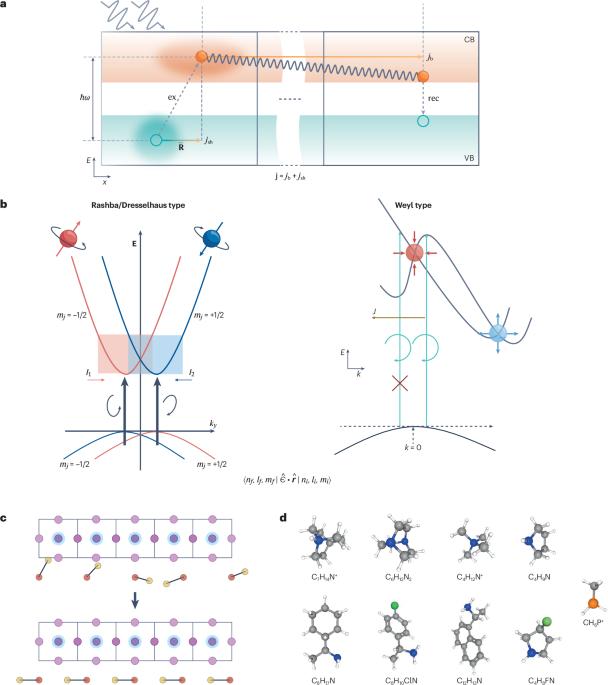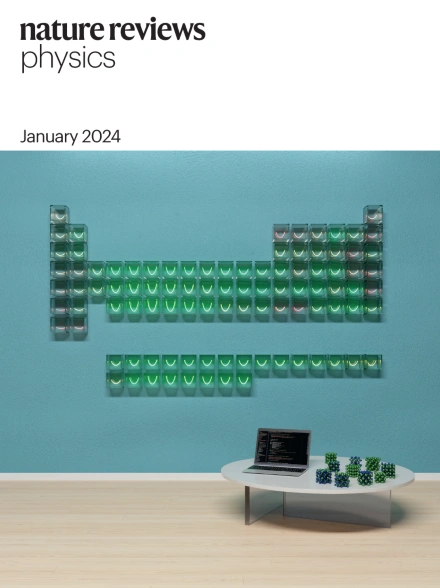Photogalvanic effects in non-centrosymmetric halide perovskites
IF 39.5
1区 物理与天体物理
Q1 PHYSICS, APPLIED
引用次数: 0
Abstract
Photogalvanic effects are characterized by the presence of light-polarization-dependent non-zero short circuit photocurrent and non-zero open circuit voltage in junction-free bulk non-centrosymmetric semiconductors and metals and have been attributed to the non-trivial Berry parameters of matter. Non-centrosymmetric ferroelectric and piezoelectric halide perovskites demonstrate a coexistence of excellent semiconducting properties, switchable or tunable Berry parameters and spin–momentum locking, and strong spin–orbit coupling, making them an ideal model system to explore the photogalvanic effects, and its use in characterizing topological properties, and to develop novel devices. In this Perspective, we describe various mechanisms to break inversion symmetry in halide perovskites and present the theory and mechanisms of the linear and circular photogalvanic effect in non-centrosymmetric halide perovskites. We discuss the roles of symmetry, strain, chemistry, interface and electric polarization on the linear and circular photogalvanic effect in non-centrosymmetric halide perovskites. We present the key opportunities and challenges of designing and harnessing photogalvanic effects in non-centrosymmetric halide perovskites for unconventional devices for spin computing, sensing and solar energy applications. Non-centrosymmetric ferroelectric and piezoelectric halide perovskites are an ideal model system to explore the photogalvanic effects. This Perspective discusses the opportunities and challenges of designing and harnessing photogalvanic effects in these materials towards unconventional devices for spin computing, sensing and solar energy applications.

非中心对称卤化物钙钛矿的光电效应
光电效应的特点是在无结体非中心对称半导体和金属中存在与光偏振相关的非零短路光电流和非零开路电压,并归因于物质的非平凡Berry参数。非中心对称铁电和压电卤化物钙钛矿表现出优异的半导体性能,可切换或可调谐的Berry参数和自旋动量锁定,以及强自旋轨道耦合的共存,使它们成为探索光电效应的理想模型系统,及其在表征拓扑性质和开发新型器件方面的应用。在这方面,我们描述了卤化物钙钛矿中破坏反转对称性的各种机制,并提出了非中心对称卤化物钙钛矿中线性和圆形光电效应的理论和机理。讨论了对称性、应变、化学性质、界面和电极化对非中心对称卤化物钙钛矿线性和圆形光电效应的影响。我们提出了设计和利用非中心对称卤化物钙钛矿中的光电效应用于自旋计算、传感和太阳能应用的非常规设备的关键机遇和挑战。非中心对称铁电和压电卤化物钙钛矿是研究光电效应的理想模型体系。本展望讨论了在这些材料中设计和利用光电效应用于自旋计算、传感和太阳能应用的非常规设备的机遇和挑战。
本文章由计算机程序翻译,如有差异,请以英文原文为准。
求助全文
约1分钟内获得全文
求助全文
来源期刊

Nature Reviews Physics
Multiple-
CiteScore
47.80
自引率
0.50%
发文量
122
期刊介绍:
Nature Reviews Physics is an online-only reviews journal, part of the Nature Reviews portfolio of journals. It publishes high-quality technical reference, review, and commentary articles in all areas of fundamental and applied physics. The journal offers a range of content types, including Reviews, Perspectives, Roadmaps, Technical Reviews, Expert Recommendations, Comments, Editorials, Research Highlights, Features, and News & Views, which cover significant advances in the field and topical issues. Nature Reviews Physics is published monthly from January 2019 and does not have external, academic editors. Instead, all editorial decisions are made by a dedicated team of full-time professional editors.
 求助内容:
求助内容: 应助结果提醒方式:
应助结果提醒方式:


